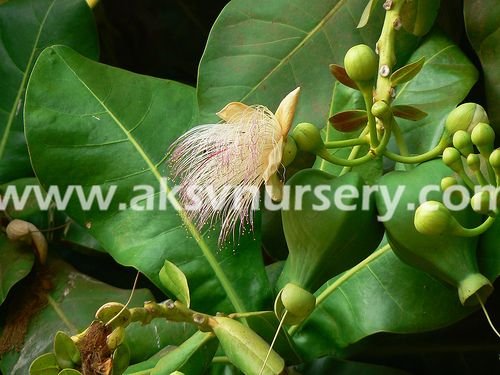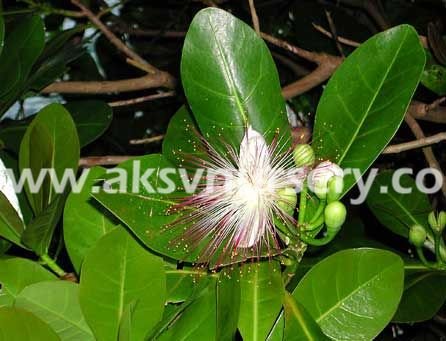Barringtonia asiatica, Mammea asiatica, Barringtonia speciosa, Agasta asiatica, Butonica rumphina
Family: Barringtoniaceae / Lecythidaceae
Sea Poison Tree, Langasat, Fish Poison Tree, Putat Laut, Butun, Butong, Pertun, Balubiton, Lugo, Motong-botong, Vuton
Origin: Coastal areas of: Indian, Madagascar, Philippines, Polynesia
This curious plant grows in sand or sand-mix with lots of water and sun. The stem will reach for up to 60Ft, and the flowers are white. It can be reproduced by seeds. What seems to be a caudex is just the large nut which will disappear by time. In habitat it is a large tree that grows on sandy and rocky shores, it has large leaves held in rosettes at the ends of branches. The young leaves are a beautiful bronze with pinkish veins. Old leaves turn yellowish. The flowers are delightful puff balls of white stamens tipped with pink. They open at night and attract large moths and nectar-feeding bats with their heavy scent. The next morning, the flower stamens are usually found strewn beneath the tree. The fruits have a typical lantern shape and float on the water. The fruit can survive drifting on the sea for long distances and for periods of up to 2 years. They were among the first seeds to arrive on the island of Krakatau when it first emerged out of the sea. The outermost layer of the fruit wall is green turning brown when ripe. The middle layer is spongy and contains air sacs to help the fruit float. The innermost layer is hard and thick to protect the seed (the layers of spongy and hard coverings are somewhat similar to the coconut). All parts of the tree contain saponin, a poison. The seeds and other parts of the plant are pounded, pulped or grated to release the poison and used to stun fish in freshwater streams. The floating seeds are sometimes used as fishing floats. A colorful shady tree, it is commonly planted as a roadside tree. The heated leaves are used to treat stomach ache and rheumatism (Philippines); seeds are used to get rid of intestinal worms.



